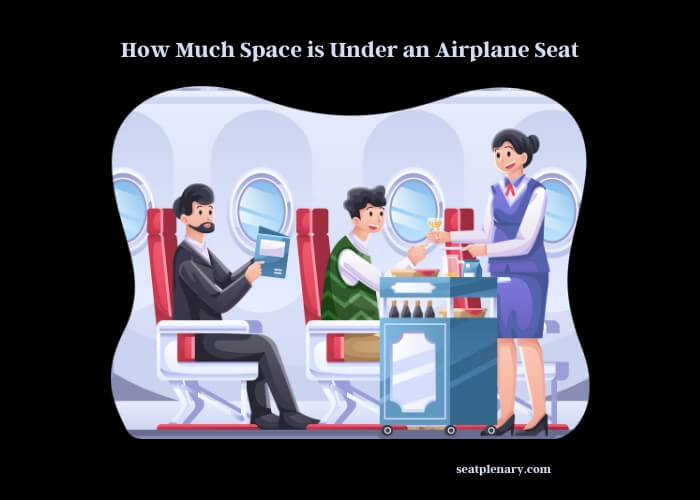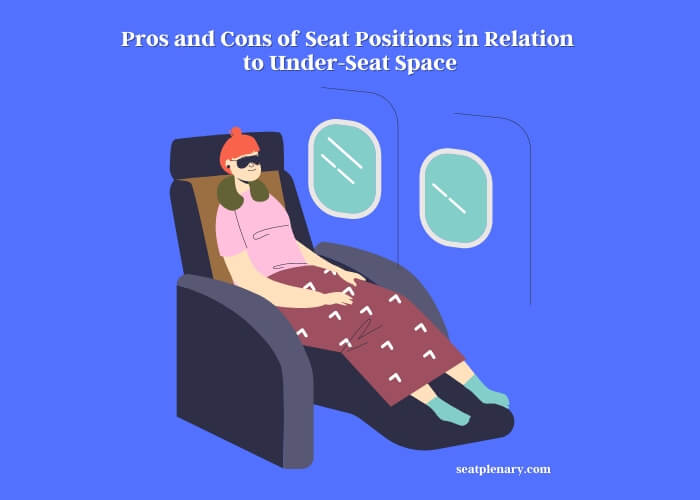The available space under an airplane seat typically does not surpass dimensions of 18 inches in length, 14 inches in width, and 8 inches in height as guided by the airline policies.
Let’s take an insightful look at this aspect. Legroom is often a critical determinant of comfort during a flight, and it is directly affected by the space under the seat. The more space there is, the more legroom a passenger has. This is especially beneficial on long-haul flights where comfort becomes paramount.

Baggage rules set by airlines come into play here as well. Passengers are usually allowed one carry-on item and one personal item. The personal item, which can be a purse or a small backpack, is meant to fit under the seat. Its size is hence restricted by the aforementioned dimensions. Larger carry-on items usually have to be stowed in overhead bins. These rules contribute to space efficiency and the smooth flow of passenger traffic within the cabin.
Airline regulations about under-seat space vary, impacting both seating and baggage arrangements. Some airlines might offer more generous under-seat space, allowing larger personal items or providing additional legroom. On the flip side, budget airlines might decrease this space to accommodate more seats. Regardless of the situation, passengers are encouraged to check their airline’s specific baggage and seating policies before flying. It helps avoid unexpected complications and ensures a more enjoyable flight experience.
Airplane Layouts
Overview of Typical Airplane Cabin Design
The space in an airplane cabin is meticulously designed to accommodate maximum passengers while ensuring comfort. The key areas include overhead compartments, seat width and pitch, and, notably, the space under the seat.
Distinct Differences: Economy vs. Business vs. First-Class
The travel class impacts the space allocation. Economy class typically offers less legroom and under-seat space compared to business and first-class, given the premium pricing of the latter.
Role of Aircraft Model on Available Space
The type of aircraft significantly influences the available under-seat space. Wide-body planes, like the Boeing 777, usually have more space compared to narrow-body aircraft like the Airbus A320 or regional jets.
In-Depth Analysis of Under-Seat Space
Breakdown of Standard Dimensions
The under-seat space typically measures around 18 inches in width, 14 inches in depth, and 8 inches in height. Still, these measurements can vary based on the airline and aircraft type.
Airline-based Variations
Different airlines have their specifications for under-seat space. Some might offer slightly more room due to their seat design and cabin layout. For example, Delta may have different dimensions compared to Southwest or United.
Influence of Seat Location (aisle, middle, or window)
The seat location can also influence the under-seat space. Aisle seats might provide slightly more room due to the extra leg space on one side, while window seats might offer less because of the plane’s curvature.
Airlines Policies and Regulations
Comparing Global Airline Policies on Under-Seat Storage
Airlines worldwide have policies regarding what can be stowed under the seat. Some limit the weight, while others restrict the type of items, typically favoring personal items like bags, purses, or briefcases.
Role of Safety Regulations
Safety regulations require under-seat space to be clear of all items during takeoff and landing. These rules ensure that there are no obstacles in case of an evacuation.
Special Considerations and Exceptions
Some airlines provide exceptions for passengers with pets or special needs, where additional items might be allowed under the seat, provided they meet specific criteria.
Comparing Under-Seat Dimensions Across Major Airlines
In this table, we’ve captured under-seat space dimensions for several major airlines. Each column indicates the width, depth, and height, providing a clear comparison. Please note that while these measurements are standard, they may vary slightly depending on the aircraft type.
| Airline | Width (inches) | Depth (inches) | Height (inches) |
| Delta | 18 | 14 | 8 |
| United | 17 | 13 | 7 |
| Southwest | 19 | 15 | 8 |
| Lufthansa | 17 | 14 | 8 |
Optimizing the Use of Under-Seat Space
Selection of Suitable Baggage for Under-Seat Storage
Choosing the right bag can maximize your under-seat storage. Look for bags specifically designed for under-seat storage that comply with the average dimensions.
Effective Packing Techniques for Space Optimization
Efficient packing can help you make the most of the available space. Roll your clothes instead of folding, use packing cubes, and avoid carrying unnecessary items.
Airline Policies – Baggage Limits and Special Provisions
In this section, we’ve compiled important details about baggage policies from various airlines. You’ll find information about the maximum weight allowed for under-seat storage and whether personal items are accepted. Keep in mind that these policies may change, so it’s always best to check the airline’s official website before packing.
| Airline | Max. Weight (lbs) | Personal Item Allowance |
| Delta | 25 | Yes |
| United | 22 | Yes |
| Southwest | 25 | Yes |
| Lufthansa | 17 | No |
Traveler Tips and Hacks
Maximizing Your Under-Seat Space
Using all available under-seat space can make your journey more comfortable. Avoid placing hard items that could become uncomfortable on a long flight.
Balancing Comfort and Storage Capacity
While it’s tempting to fill up all the under-seat space, remember to balance it with your comfort. Leaving a little free space can provide more room for your feet.
Pros and Cons of Seat Positions in Relation to Under-Seat Space

The seat you choose can greatly influence your access to under-seat space. This table breaks down the advantages and disadvantages of different seat positions – aisle, middle, and window. Consider these factors to make an informed choice and optimize your in-flight comfort and convenience.
| Seat Position | Pros | Cons |
| Aisle | Extra leg space | May be bumped by passengers |
| Middle | Equal access to both under-seat areas | Less total space |
| Window | Undisturbed, some additional side space | Less under-seat space |
Future Perspectives on Under-Seat Space
Potential Alterations in Airplane Designs
Future aircraft designs could alter under-seat dimensions, especially as airlines seek ways to enhance passenger comfort and optimize cabin space.
Impact of COVID-19 on Under-Seat Space and Baggage Policies
COVID-19 has led to changes in baggage policies with some airlines encouraging less carry-on luggage. This could impact future under-seat space use.
Sustainability and Under-Seat Storage
Airlines striving for sustainability might consider reducing the amount of permitted cabin baggage, leading to changes in under-seat storage space and usage.
FAQs
How Big Is the Space Under a Seat on an Airplane?
On average, the space under an airplane seat is approximately 18 inches wide, 14 inches deep, and 8 inches tall. Yet, these measurements can vary slightly depending on the aircraft model and airline.
What Are the Under-Seat Dimensions for Delta Airlines?
For Delta Airlines, the under-seat dimensions typically measure about 18 inches in width, 14 inches in depth, and 8 inches in height. It’s always wise to check the latest details on the Delta Airlines website as specifications might vary.
What Size Bag Fits Under a Seat on American Airlines?
American Airlines allows a personal item that fits under the seat in front of you, measuring up to 18 inches x 14 inches x 8 inches. This includes handbags, laptop bags, or small backpacks.
Can I Know the Under-Seat Dimensions for a Boeing 737-800?
The under-seat dimensions on a Boeing 737-800 are generally around 17 inches wide, 20 inches deep, and 11 inches tall. Keep in mind that this can vary depending on the specific seat and aircraft configuration.
Why Does the Under-Seat Size Vary on Different Aircraft Models?
The under-seat size can differ due to the design of the airplane, including factors such as the model of the aircraft, seat configuration, and the class of service. Larger planes, like wide-body aircraft, usually offer more under-seat space than smaller planes.
Are There Any Restrictions on What Can Be Placed Under an Airplane Seat?
Yes, airlines typically have restrictions on what can be stowed under the seat. Items should be able to fit within the designated under-seat dimensions without obstructing the aisle. Additionally, for safety reasons, all items must be stowed during taxi, takeoff, and landing.
What Are the Under-Seat Dimensions for an Airbus A320?
The under-seat space on an Airbus A320 typically measures about 18 inches in width, 14 inches in depth, and 8 inches in height. However, these figures might vary depending on the airline and the seat location.
References
Read More:
- Socket Sizes for Removing Silverado Seats: A Practical Guide
- How Are Airplane Seats Numbered: A Complete Guide
- Does Doona Fit in Airplane Seat? – A Compatibility Guide
- All About Laying Across Airplane Seats for Your Comfort
- Air Travel at Size 24: Tips for Comfortable Seating Onboard
- Where is Seat A on a Plane: An Insightful Flight Seating Guide
